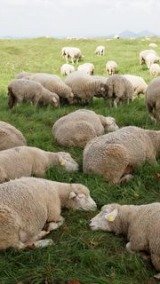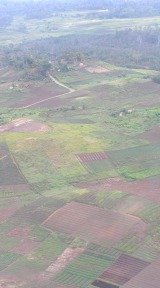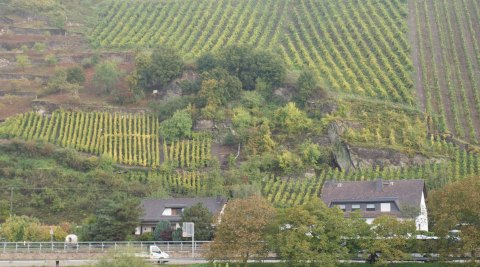Home | About CCW | Contact Us | Climate change Meaning | Causes | Solutions | Emissions | Carbon trading
Climate change agriculture
Climate change agriculture is a serious conundrum because
- modern agriculture contributes to anthropogenic climate change through land clearing, methane production from livestock, fossil fuel emissions and the use of nitrogen fertilizers that release nitrous oxide an especially potent greenhouse gas
- agricultural production is at risk from climate change effects meaning that farmers and agri-business are exposed to severe weather, drought and seasonal shifts
- management of agricultural land can be part of the solutions for global warming especially through biosequestration of carbon into vegetation and soil
Let’s take a look at each of these...
Agricultural contributions to climate change
At first glance our agricultural practices are more important contributors to greenhouse gas emissions than we would care to admit.
Clearing land to grow crops and graze animals still amounts to 13% of annual global GHG emissions, on a par with emissions from transport. And with feed demand increasing there it is hard to see this proportion declining without a major shift in priorities.
Then there are several GHG emission sources once farming is underway:
- fossil fuel consumption from farm machinery (CO2, methane)
- fossil fuels from transport of produce to market and fertilizer to the farm (CO2, methane)
- enteric emissions from livestock (methane)
- fertilizer use (CO2 from energy generated to make fertilizer, N2O)
- pesticide and herbicide use (CO2 and methane from energy needed for manufacture)
- residue management (CO2, methane from decomposition and/or burning)
- soil degradation (CO2)
Given this list, it is no wonder that many of the farm lobby groups want to keep climate change agriculture far away from emission trading schemes.
From where the farmer is sitting it's too easy to paint what he does as a greenhouse gas liability and as much a cause of the global warming issue as transport and fossil fuel energy production.
Agriculture at risk from climate change
The aim of agriculture is food and fibre production.
In the west this happens in businesses operating to make profit in the marketplace, but a large proportion of global food production is subsistence – food sufficient to support the grower and his/her family. Roughly half the people alive are fed by subsistence agriculture.
Food leaves the farm and with it carbon and nutrients. Over time this creates an imbalance that is made up by inputs of fertilizer and mechanical energy.
Without these nutrient and energy subsidies yields decline, often very quickly, and the only option is to move production to another place — this is the method for much subsistence production often called shifting agriculture.
Yet thanks to the remarkable regenerative and storage capacity of soil, farming has worked for us. Rested soils accumulate carbon and recover some of their productivity allowing rotation.
However, human population growth has created a huge demand that must be met each and every year to feed ever growing numbers of people.
Maintaining such production is a challenge we’ll leave for another discussion. What we must realise is that production puts great pressure on soils as they become depleted of carbon and nutrients.
Some of our intensive farming practices push the capacity of soils to the limit increasing reliance on inputs. Soils at the limit are more vulnerable to the effects of climate change agriculture.
Find out more climate change wisdom on soils and climate
Once low input systems degrade the farmer must move on to clear new lands, often in marginal country where rain or nutrients are uncertain or extreme weather is a problem. These marginal conditions are also at risk from the effects of climate change .
What climate change brings are rainfall, temperature and extreme weather events that are outside the norm. Any system running hard at the margins has limited reserves (resilience) and risks failure.
This risk applies to much of our modern agricultural production.
Agriculture as part of the climate change solution
Fortunately it is not all doom and gloom.
Solutions for both resilient production and climate mitigation exist that go back to the foundation of how plants grow... the soil.
Plants are physically rooted in the soil and they use it to access essential water and nutrients. Sunlight and CO2 are enough to let photosynthesis do the rest.
The details are complex but the principle is very simple.
In the past it made economic sense to mine the soil of its nutrients and carbon and grow as much food as possible — just as it usually makes economic sense to convert assets to cash for financial investment — but, in farming, this way of making money erodes the foundations of production.
In many places this is what has happened, vegetation has been cleared and soil depleted to deliver production.
There is a new opportunity though. These depleted soils can be rehabilitated. Often this can be with something as simple as a cover of plants throughout the year.
What rehabilitation means is returning carbon to the soil to rekindle the biological activity. And, in time, carbon is stored ['sequestered' is the technical term].
Agriculture has the potential to sequester much of the excess CO2 emitted from its own activity and be a net sink of carbon for other anthropgenic greenhouse gas emissions.
In fact it is essential that we take this opportunity to sequester carbon in both degraded and productive land and resolve the climate change agriculture conundrum for two critical reasons:
- The annual sequestration potential is as much as 10% of the amount emitted to the atmosphere each year from anthropogenic activity
- Managing for carbon sequestration will be the best adaptation to climate change we can make
Some more climate change agriculture ideas are considered in these Climate-change-wisdom pages:
[climate change wisdom] › climate change agriculture
Recent Articles
-
Reducing emissions while looking for solutions...
Nov 01, 15 04:46 PM
I've seen a lot of post's online for ideas on reducing emissions. The one suggestion I have not seen, is the most obvious. There should be a government -
Climate change evidence
Mar 24, 15 06:22 AM
Real climate change evidence has to demonstrate a change in climate. An extra sunny day or a severe storm or a flood is not enough. -
The climate change effect
Feb 19, 15 03:08 AM
What will be the climate change effect? There isn't one, there are many. Perhaps too many for us to understand.




New! Comments
Have your say about what you just read! Leave me a comment in the box below.